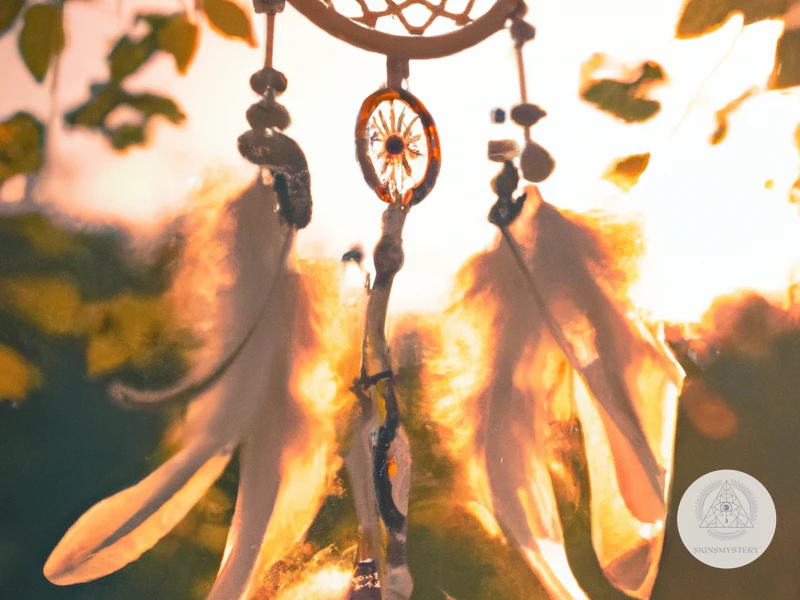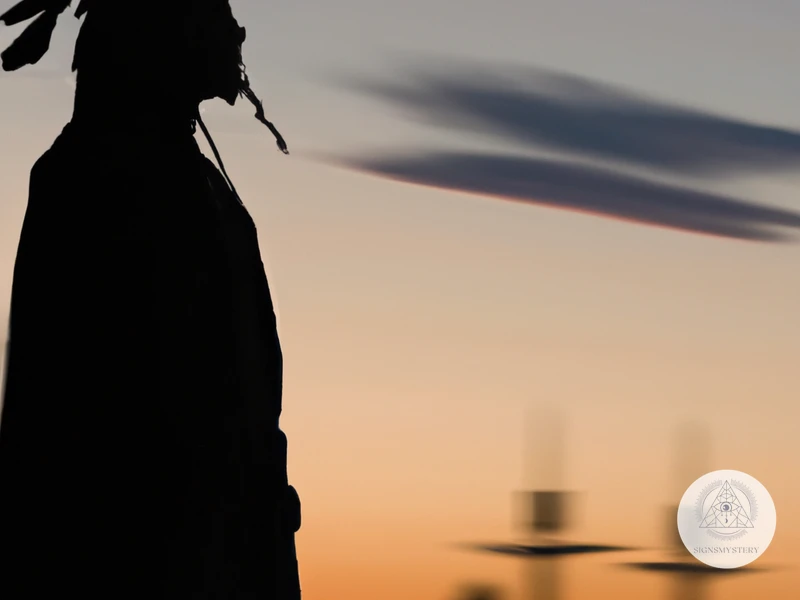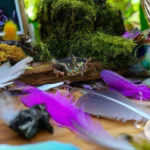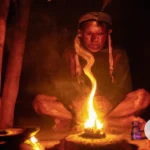Native American Shamanism is often regarded as one of the mystical practices that have survived the test of time. For many centuries, shamanism has been a significant part of Native American culture. The practice gained popularity due to its perceived healing powers, and it has been passed down from generation to generation. In this article, we will explore the history and evolution of Native American Shamanism, from its origins to its modern-day practice. We will delve into the role of shamanism in Native American culture, the impact of European settlement, and the challenges and controversies surrounding the appropriation of the practice. So, let us take a journey into the mystical world of Native American Shamanism.
The Origins of Native American Shamanism

Native American Shamanism is an ancient spiritual practice that dates back to prehistoric times. Prehistoric Shamanism was the earliest form of shamanism and was characterized by the use of hallucinogens to reach altered states of consciousness. The Olmec, Maya, and Aztec civilizations also had a significant influence on the development of Native American Shamanism. They believed in the power of sacred plants to communicate with the spirit world and access divine knowledge. The practice of shamanism varied among the different Native American tribes and regions. Some shamanic practices involved healing through spiritual and physical methods, divining the future, and communicating with the dead. The role of shamans was also diverse, ranging from medicine men and women to spiritual advisors and leaders.
Prehistoric Shamanism
Prehistoric shamanism is the oldest form of spiritual practice known to mankind. It dates back to the Paleolithic era, more than 30,000 years ago. The term “shaman” comes from the Tungus people of Siberia, where shamanism was practiced extensively. However, the practice of shamanism existed in many parts of the world, including the Americas.
In the prehistoric era, shamanism was practiced by hunter-gatherer societies, and its primary purpose was to connect with the spirits of animals and plants for sustenance and healing. The shaman would enter into a trance state using various techniques such as drumming, dancing, and the use of psychoactive plants. Once in a trance state, the shaman would communicate with the spirits of the natural world and seek their guidance and wisdom.
Prehistoric shamanism was also closely tied to cave art, which depicts various shamanic practices such as dancing, hunting, and the use of psychoactive plants. These cave paintings provide evidence of the spiritual practices of our ancestors and the importance of shamanism in their way of life.
Although there is little written information about prehistoric shamanism, anthropologists have pieced together its practices through the study of contemporary hunter-gatherer societies and the examination of artifacts and cave paintings. The influence of prehistoric shamanism can still be seen in modern-day shamanic practices, including those of Native American tribes.
Prehistoric shamanism was a foundational practice that laid the groundwork for the evolution of shamanism across cultures and centuries. Its influence on Native American shamanism is significant and cannot be ignored. To learn more about Native American shamanism and its evolution, read on to the next sections of this article or visit our page on Native American shamanism.
The Influence of Ancient Mesoamerican Cultures
Historians suggest that the roots of Native American shamanism can be traced back to the ancient Mesoamerican cultures. The Mayans, Aztecs, and Incas, who inhabited present-day Mexico and Central America, were known for their advanced knowledge of astronomy, mathematics, and agriculture. They also had a deep spiritual connection with nature and believed in the existence of a higher power that governed the universe.
Their belief system, combined with their advanced understanding of the cosmos, had a profound influence on the development of Native American shamanism. The Mesoamerican cultures believed that plants, animals, and even inanimate objects possessed a spiritual essence that could be harnessed through rituals and ceremonies. These practices included the use of “entheogenic” plants that contained psychoactive compounds, such as mushrooms and peyote.
Native American shamans adopted many of these practices, integrating them into their own spiritual traditions. The use of entheogenic plants, for example, became a prominent feature of many Native American shamanic ceremonies. They were believed to have healing properties and could connect the participants to the spiritual world.
The Mesoamerican cultures also had a strong tradition of blood sacrifice, which they believed was necessary to appease the gods and maintain balance in the universe. While Native American shamanism did not emphasize blood sacrifice to the same extent, it did adopt certain elements of the practice. Animal sacrifice, in particular, was common in many Native American shamanic rituals and was believed to be a way of making offerings to the spirits.
The influence of the ancient Mesoamerican cultures on Native American shamanism was substantial. The practices and beliefs of the Mayans, Aztecs, and Incas were integrated into Native American spiritual traditions, creating a complex system of rituals, ceremonies, and beliefs that have lasted to this day.
Native American Shamanism before the European Colonization
Native American Shamanism had deep roots in the culture and spirituality of indigenous people before the arrival of European colonizers. The role of Shamanism was significant in the Native American community as it was responsible for interpreting and communicating with the spiritual world. Shamans were respected members of their communities, who performed various rituals, healings, and other activities to ensure the well-being of their people. There were different types of shamanism in different tribes with their unique practices and beliefs, such as Anishinaabe, Lakota, and Navajo. Some of these practices include sweat lodges, vision quests, and trance dancing. These rituals were profoundly important in maintaining the spiritual balance of individuals and the community as a whole. In the absence of written history, the stories and traditions passed down from generation to generation were preserved through oral traditions that still exist today.
The Role of Shamanism in Native American Culture
The role of shamanism in Native American culture cannot be overstated. From healing and ceremony to divination and community leadership, shamanism was a fundamental aspect of Native American life. Here are some of the ways in which shamanism impacted Native American culture:
| Role | Description |
|---|---|
| Ceremonial Leader | Shamans were often the leaders of religious ceremonies, which were central to Native American communal life. These ceremonies included the Sun Dance, Sweat Lodge, and Vision Quest. |
| Healer | Shamanic healing was a vital part of Native American medicine. It involved the use of herbal remedies, spiritual guidance, and sometimes even physical manipulation of the patient’s body. |
| Diviner | Shamans used various methods to foretell the future and gain insight into important issues. These methods included interpreting dreams, casting bones, and communicating with the spirit world. |
| Spiritual Guide | Shamans were spiritual guides to their people, helping them connect with the divine and understand their place in the world. They also helped their communities to maintain a harmonious relationship with nature. |
| Storyteller and Teacher | Shamans were responsible for passing down the history and traditions of their people through storytelling and teaching. This helped to maintain a sense of cultural continuity and identity. |
Shamanism was not only a religion, but also a way of life for many Native American tribes. It played a crucial role in fostering community cohesion and social order. The shaman was seen as a mediator between the physical and spiritual realms, and his or her role was vital to ensuring the well-being of the tribe. Today, many Native American communities still maintain shamanic practices as part of their heritage and identity.
The Different Types of Native American Shamanism
The Different Types of Native American Shamanism vary from tribe to tribe and region to region. Each tribal group has its own distinct practices and beliefs regarding shamanism. The role of a shaman in Native American societies is to act as a mediator between the physical and spiritual worlds. Shamans are envisioned as possessing the power to heal, protect, and forecast the future while in a trance state.
One type of shamanism is the Ritualistic Shamanism, commonly practiced by the Sioux tribe. The shaman will perform certain rituals to enter a heightened state of awareness and connect to the spirit world to bring back information that can resolve problems and conflicts in the tribe.
Another type is the Visionary Shamanism practiced by the Amazonian tribes. The shaman will seek to communicate with the spiritual world by ingesting psychoactive plants during trance-like states. This type of shamanism focuses on using visionary experiences to heal the body and mind.
The third type of shamanism is called Ecstatic Shamanism, commonly practiced by the Plains tribes. Ecstatic shamans will use repetitive sounds such as drumming, rattling, and chanting to enter a trance-like state and connect with the spirit world. This type of shamanism focuses on personal transformation and healing.
A fourth type of shamanism is called Inner Journey Shamanism, which is practiced by various tribes across North America. The shaman will guide the individual through a guided meditation, allowing them to gain insight and find solutions to their problems. This type of shamanism focuses on helping individuals attain personal growth and discovery.
It’s important to note that these different types of Native American Shamanism are not mutually exclusive. Many shamans may incorporate elements of different types of shamanism according to the needs of the individual or the tribe. Understanding these different types of shamanism is crucial in understanding the role of shamans in Native American societies.
It’s fascinating to see how each tribe developed its unique practices and beliefs. To get a better picture of how Native American Shamanism evolved and influenced modern-day shamanism, check out our article “The Influence of Native American Shamanism”.
The Impact of European Settlement on Native American Shamanism

The arrival of Europeans to America caused a significant impact on Native American shamanism. With the introduction of Christianity, the new settlers viewed indigenous spiritual practices as primitive and uncivilized, leading to the suppression of shamanism. Forced assimilation efforts, such as the Indian Religious Crimes Code of 1883, made it illegal for Native Americans to practice their spiritual traditions. This oppression caused a decline in the practice of shamanism amongst Native Americans. However, the suppression of shamanism did not eliminate it entirely. The resilience of Native American shamanism is demonstrated by the revival of the practice in the 20th century, which is still continued today. Despite the efforts of Europeans to erase indigenous spiritual practices, the influence of shamanism on Native American culture cannot be denied.
Forced Assimilation and the Suppression of Shamanism
During the colonization of North America, Native American cultures faced forced assimilation by European settlers. One of the most significant impacts of this was the suppression of Native American shamanism. European colonizers viewed shamanism as a primitive and savage practice that went against their own religious beliefs. Because of this, they aimed to eliminate shamanism and convert Native Americans to Christianity.
Missionaries and other Christian leaders often targeted shamans because they were seen as influential figures in their communities. For instance, many shamans were responsible for leading important ceremonies and guiding the spiritual lives of their people. However, they were often portrayed as charlatans or demonic figures by European colonizers. As a result, shamans were forced to hide their practices or face persecution and punishment.
One of the most effective ways that European settlers suppressed shamanism was through the establishment of boarding schools. These schools aimed to assimilate Native American children by separating them from their families and communities and teaching them Western culture and values. They were often forbidden from practicing their own spiritual traditions, including shamanism. Boarding school staff would physically punish children who were caught practicing shamanism and would instead encourage them to adopt Christian faith.
This suppression of Native American shamanism had devastating impacts on traditional cultures, as it resulted in the loss of valuable knowledge and practices. Many Native Americans turned away from their spiritual traditions as a result of the forced assimilation and the stigmatization of shamanism. However, some communities have been able to preserve their shamanic practices and pass them down to younger generations.
It’s worth noting that the suppression of shamanism has continued long after the colonial period. Native American communities continue to face challenges in practicing their spiritual traditions and have had to fight for legal recognition of their religious rights. The appropriation of Native American shamanism by non-Native individuals has created controversy and further complicated the practice of shamanism in modern times.
The Revival of Native American Shamanism
The suppression of Native American culture and spirituality by colonial powers had a
Subscribe to Our Newsletter
Sign up to receive the latest news and updates.
One of the most important factors contributing to the revival of Native American shamanism has been the recognition and acknowledgment of past injustices by the US government and non-indigenous people. There has been a growing awareness of the harm done by colonialism and the forced assimilation of Native Americans, which has led to increased efforts to support Native American communities and protect their cultural heritage.
As a result, many indigenous people have been able to reconnect with their spiritual traditions and revive the practice of shamanism that was suppressed for so long. Shamanic practices have become more mainstream in recent years, with many non-indigenous people seeking out these spiritual traditions as a way to connect with the natural world and find their own sense of purpose.
However, it is important to note that the revival of Native American shamanism has not been without controversy. Some indigenous people are concerned about practices being appropriated by non-indigenous people without proper understanding or respect for the cultural context. There are also concerns about commercialization and the commodification of spiritual practices, which can trivialize and undermine their significance.
Despite these challenges, the revival of Native American shamanism represents an important step towards healing and reconciliation between indigenous and non-indigenous people. It is a testament to the resilience and perseverance of Native American communities, who have managed to preserve their spiritual traditions in the face of significant adversity. With continued efforts to support and revitalize Native American cultures, the practice of shamanism will likely continue to be an important part of the spiritual landscape for many years to come.
The Modern-Day Practice of Native American Shamanism
The modern-day practice of Native American shamanism evolved from ancient beliefs and traditions. Today, many individuals with diverse backgrounds seek to learn and integrate shamanic teachings into their daily lives. The practice focuses on connecting with nature, accessing the spiritual realm, and healing the self and others. Shamanic ceremonies and rituals involving the use of drumming, chanting, and dancing are still practiced by indigenous communities and those who have learned from them. However, the appropriation of Native American shamanism by non-indigenous people has led to controversy and calls for respect and understanding of its sacredness. To truly understand and honor this ancient practice, education and respect for Native American culture and ethics is vital.
The Integration of Shamanic Traditions into Contemporary Society
The integration of shamanic traditions into contemporary society involves adapting the ancient practices of Native American shamanism to modern times. This process has led to the emergence of new forms of shamanism that incorporate elements of Western spirituality, alternative medicine, and psychotherapy.
One example of this integration is the use of shamanic practices in addiction treatment. Many addiction treatment centers now incorporate shamanic traditions into their programs, using techniques such as drumming, chanting, and ritual to aid in the recovery process. The use of shamanic practices in addiction treatment is based on the belief that addiction is often rooted in a spiritual imbalance or disconnection, and that shamanic practices can help to restore that balance and reconnect individuals with their higher selves.
Another example of the integration of shamanism into contemporary society is the use of shamanic techniques in psychotherapy. Some therapists use shamanic journeying, a technique that involves entering a trance state and communicating with spiritual entities, as a way of accessing the unconscious mind and healing emotional wounds.
In addition to these more therapeutic applications, shamanic traditions have also been integrated into mainstream spirituality. Many people incorporate shamanic practices such as meditation, breathing exercises, and energy healing into their daily spiritual practice.
Despite the benefits of integrating shamanic traditions into contemporary society, there is also some controversy surrounding this process. Some Native American leaders object to the appropriation of their traditions by non-Native individuals, arguing that these practices are sacred and should be respected as such. Additionally, there is concern that the commodification of shamanic practices could lead to their dilution or distortion, as people seek to profit from the popularity of these practices.
Although the integration of shamanic traditions into contemporary society remains a contentious issue, many people continue to find value in these practices and incorporate them into their daily lives. As long as this integration is done responsibly and respectfully, it has the potential to create a more holistic and spiritually satisfying way of life for those who embrace it.
Internal link: Native American Shamanic Ceremonies are one of the practices that have been integrated into contemporary society.
The Challenges and Controversies of Appropriating Native American Shamanism
The practice of appropriating Native American shamanism has become a controversial subject, with many indigenous people arguing that it is a form of cultural theft. The appropriation of their beliefs and practices undermines their autonomy and disrespects their spiritual traditions.
One of the biggest challenges in appropriating Native American shamanism is the cultural and spiritual differences between indigenous traditions and modern Western practices. Native American shamanism is based on a deep spiritual connection with nature, ancestors, and other spirits, which cannot be easily translated or replicated without an understanding of the specific cultural and historical context.
The commodification of Native American shamanism has led to the exploitation of their sacred practices for profit. Non-indigenous people selling Native American ritual items, such as dreamcatchers or smudging kits, without understanding their significance, appropriates their culture, and the profits do not find their way back to their communities.
Another controversy surrounding the appropriation of Native American shamanism is the issue of ethics. Many indigenous people view their spiritual practices as sacred and believe that only those who are initiated within their community can perform them responsibly. When non-indigenous people appropriate their traditions, it disrupts the spiritual balance and violates their spiritual laws.
The appropriation of Native American shamanism raises many ethical and cultural challenges. Rather than appropriating these practices, it is essential to respect and appreciate them within their specific cultural and historical context. We can take inspiration from them and learn from their spiritual connection with nature and spirits but must be mindful of the cultural and ethical implications of their appropriation. Native American Shaman beliefs and practices are unique and cannot be replicated or commodified without an understanding of their specific context and meaning.
Conclusion
After exploring the rich history and evolution of Native American Shamanism, it is clear that this ancient practice has undergone significant changes throughout the centuries. Despite centuries of forced assimilation and suppression, Native American Shamanism has managed to survive and thrive into the modern era.
Today, there is a global interest in shamanic practices and spirituality, and many people are turning to Native American Shamanism for guidance. However, it is important to recognize the significant cultural differences between Native American traditions and those of other cultures. While there are similarities between various shamanic practices, each culture has its own unique set of beliefs and practices that should be respected and honored.
The practice of Native American Shamanism continues to evolve and adapt to the modern world. While some traditional practices may have been lost over time, many Native American communities continue to honor and practice their shamanic traditions. Furthermore, many non-Native people have embraced shamanic practices and integrated them into their own spiritual journeys.
As with any spiritual practice, it is important to approach Native American Shamanism with respect and humility. It is crucial to acknowledge and honor the history and traditions of the people who originated these practices.
Ultimately, Native American Shamanism offers a powerful connection to the natural world and our own inner selves. By embracing the wisdom and teachings of the ancestors, we can find a deeper sense of purpose, meaning, and connection in our lives.
References:
Frequently Asked Questions
What is shamanism?
Shamanism is an ancient spiritual practice that involves connecting with the natural world and the realm of spirits to achieve healing, wisdom, and guidance.
What role did shamanism play in Native American culture?
Shamanism played a crucial role in Native American culture, serving as a source of spiritual guidance, healing, and cultural transmission.
What were the different types of Native American shamanism?
There were many different types of Native American shamanism, including the Vision Quest, the Sweat Lodge, and the Medicine Wheel.
What impact did European settlement have on Native American shamanism?
European settlement had a devastating impact on Native American shamanism, leading to the forced assimilation of Native Americans and the suppression of their traditional spiritual practices.
What is the current state of Native American shamanism?
The current state of Native American shamanism is complex, with some traditional practices continuing to be passed down through generations and others being integrated into contemporary society.
What are some challenges in appropriating Native American shamanism?
Some challenges in appropriating Native American shamanism include the lack of cultural context and understanding, highly commercialized versions of shamanism, and issues of cultural appropriation.
What is the medicine wheel in Native American shamanism?
The medicine wheel is a symbolic representation of the interconnectedness of all things in the natural world and the four directions, often used in Native American shamanic practices.
What is a vision quest in Native American shamanism?
A vision quest is a traditional Native American practice in which an individual seeks spiritual guidance from the natural world by fasting and spending time alone in nature.
What is a sweat lodge in Native American shamanism?
A sweat lodge is a ceremonial structure used to purify the body and connect with the spirits, often involving the use of hot rocks and steam to induce a state of sweat and spiritual cleansing.
What is the importance of respecting Native American shamanic traditions?
The importance of respecting Native American shamanic traditions lies in recognizing the cultural significance and spiritual value of these practices to Native American communities, and avoiding commercialization and cultural appropriation.










